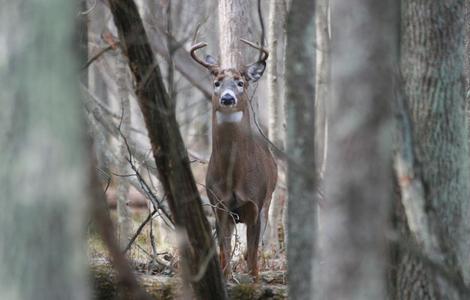In Texas, most of the white-tailed deer are on the tail-end of the rut. There are a few areas of the state that are notable exceptions, with the south Texas rut just warming up. However, deer in most parts of the state have finished the first and most important breeding cycle. Does that were not bred during their first cycle will come back into heat 28 days later, so bucks will continue to search out these ladies. But even if the rut is almost over and only a single un-bred doe exisits in your area, there are still some tactics you can use to be successful at late season, post rut whitetail.
Once the primary rut is over, does will search out winter food sources and start to re-group. Early season hunting strategy usually calls for hunters setting up along scrapes or rub lines, but the success rate of this technique drops rapidly after the majority fo the rut as occurred. Rather than looking for buck sign, look for signs of does. Find the portion of the property where you hunt that has the highest concentration of does. Go there. This is probably not the place where your stand is located. Deer can pattern hunters just as easy, if not easier, than hunters can pattern deer. After all, the deer are out there all of the time!
If there is a single un-bred doe on your ranch, the chances of seeing that deer are better where you view the highest number of deer. This may make sense, but you would be surprised at the number of hunters that always see deer in one particular area, but continue to drive to their stand and wait it out by a food plot or feeder. Deer are wise late in the season. They are out there, but they will not readily approach your food plot or feeder because of hunting pressure. Your job is to find out where those deer can be found after the sun comes up and the sun goes down.
Remember, although you are looking for late rut does, you are really only using them to attract a lonely buck to you. Once feeding areas have been identified, it will pay to find bedding areas. The value of bedding areas has been stressed in the literature so much that we are all blue in the face, but it is very important. Let’s say you are hunting a food plot, a feeder, or an area where deer come to feed on native plants. It doesn’t matter. When deer have been hunted by you, your hunting buddies, and your neighbors, deer get smart. Searching for whitetail does can be the most difficult task, but your post rut success hinges on finding them. Any doe coming into a second or late estrus will leave her scent, but where is she?
In many parts of the country, the doe segment of a deer population has a better age structure than the buck segment. In short, this means unless you are hunting a property that has a good deer management program in place, there are more old does running around than there are old bucks. We all know how this occurs. So yes, many of the does are actually smarter than the bucks we hunt because they have been through hunting season after hunting season after hunting season. And guess what? They are still there.
So what’s next? Simply said, evening feeding patterns are easier to predict than morning feeding patterns. This is because deer know they will bed up nearby after dark, especially during the dark of the moon. A common occurence is for is for evening-feeding deer to “hang up” in nearby cover before heading out to feed just before sunset. So if you are hunting an evening food source, rest assured that deer are not far away. The trick to is to get to them before your hunting light is gone.
This is where hunting setup is important. Let’s say you have identified the highest density of deer, the food source these animals are using, and where they are bedding up after dark. Since hunting between the feeding and bedding area will not payoff on late-feeding deer at this point in the season, the trick is to hunt near the food source, but between the food source and the direction the deer are coming from. That’s right, you are going to have to get out of your tripod or box blind. Once the feeding route is known, back off the food source by about 100 to 150 yards and set up shop. Make either a small inconspicuous brush blind or use a climbing stand. Make sure you get there before the deer do, watch the wind, and keep an eye out for either a hungry buck or a buck looking for an un-bred doe!
